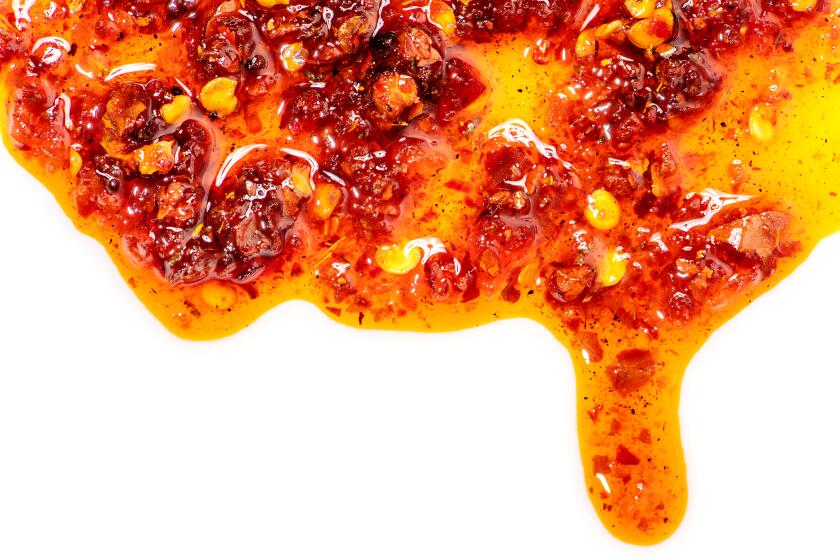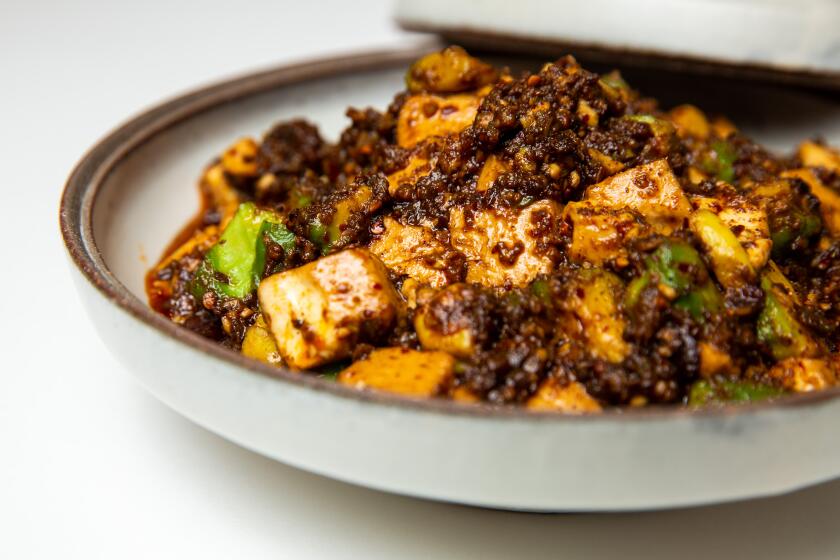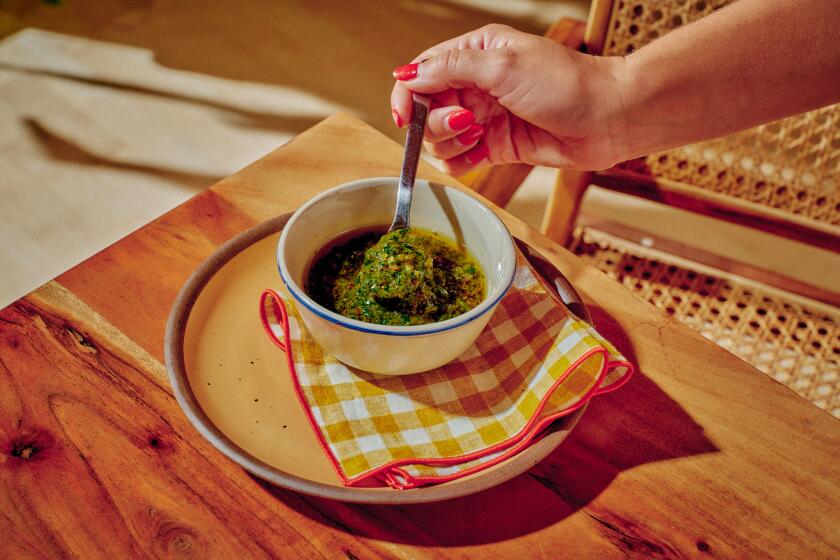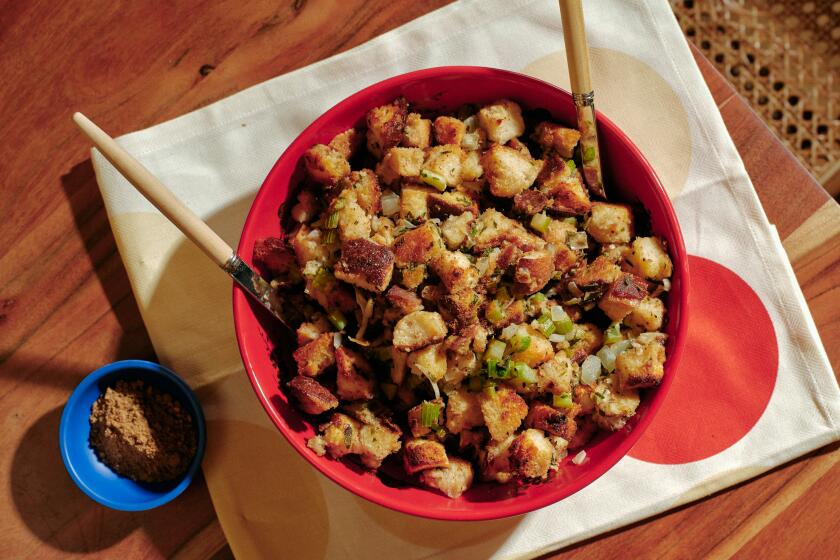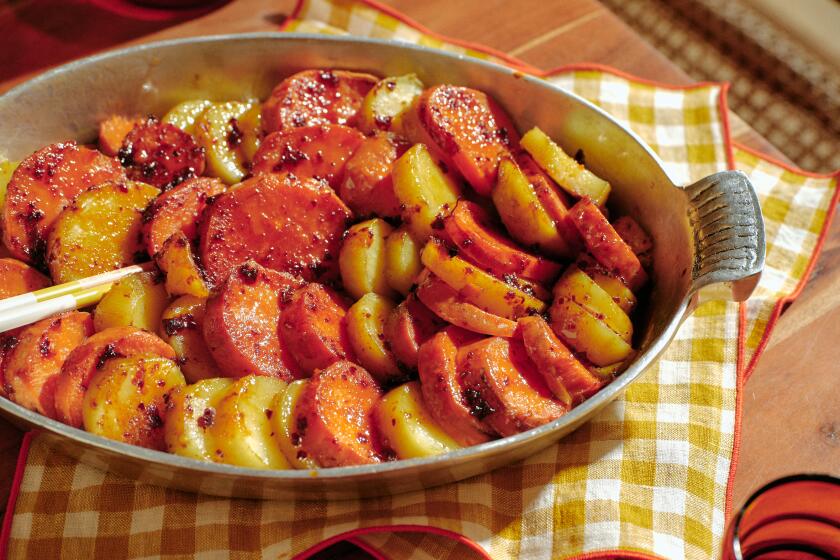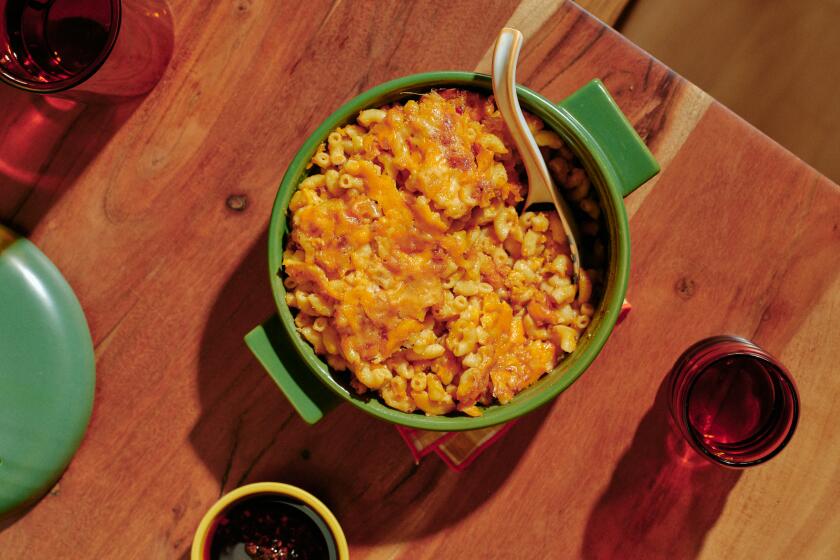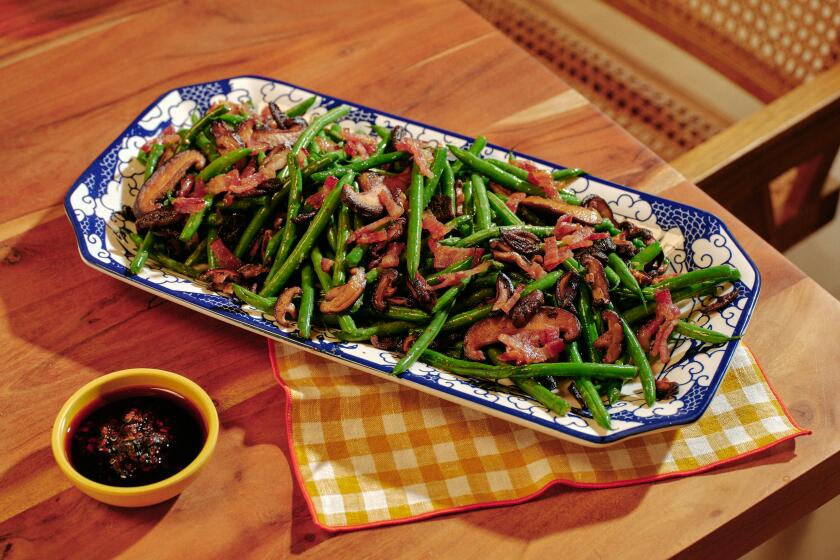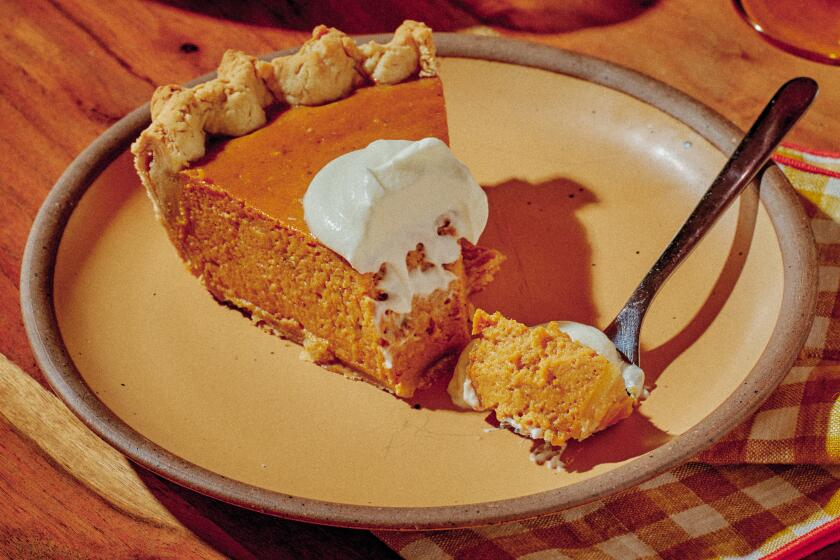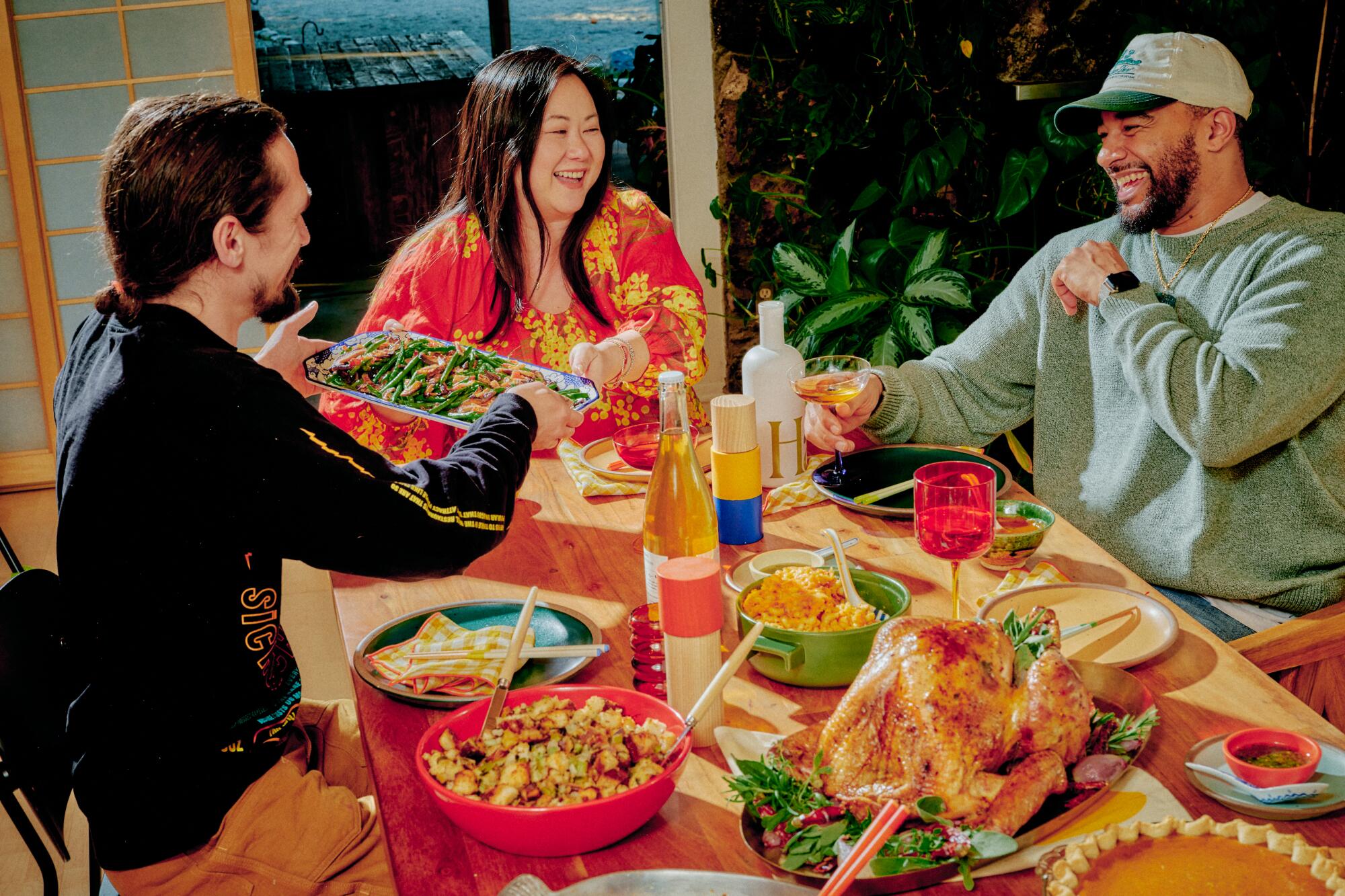
- Share via
By 10 a.m. on a recent sunny morning, the kitchen in Jing Gao’s Midcentury Modern house, set into a canyon-view Sherman Oaks hillside, is filled with the aroma of rosemary, sage, nutmeg, cloves, sesame oil and erjingtiao chiles.
For the first time since she moved to the U.S., Gao — who has lived in China, Europe and Canada — is planning to make a Thanksgiving dinner that isn’t hot pot.
She stands before her pantry, its floor-to-ceiling double doors swung open to reveal hundreds of spices and condiments she has amassed from around the world as the founder of L.A.-based chili crisp maker Fly by Jing.
“Everything I do revolves around flavor,” Gao says.
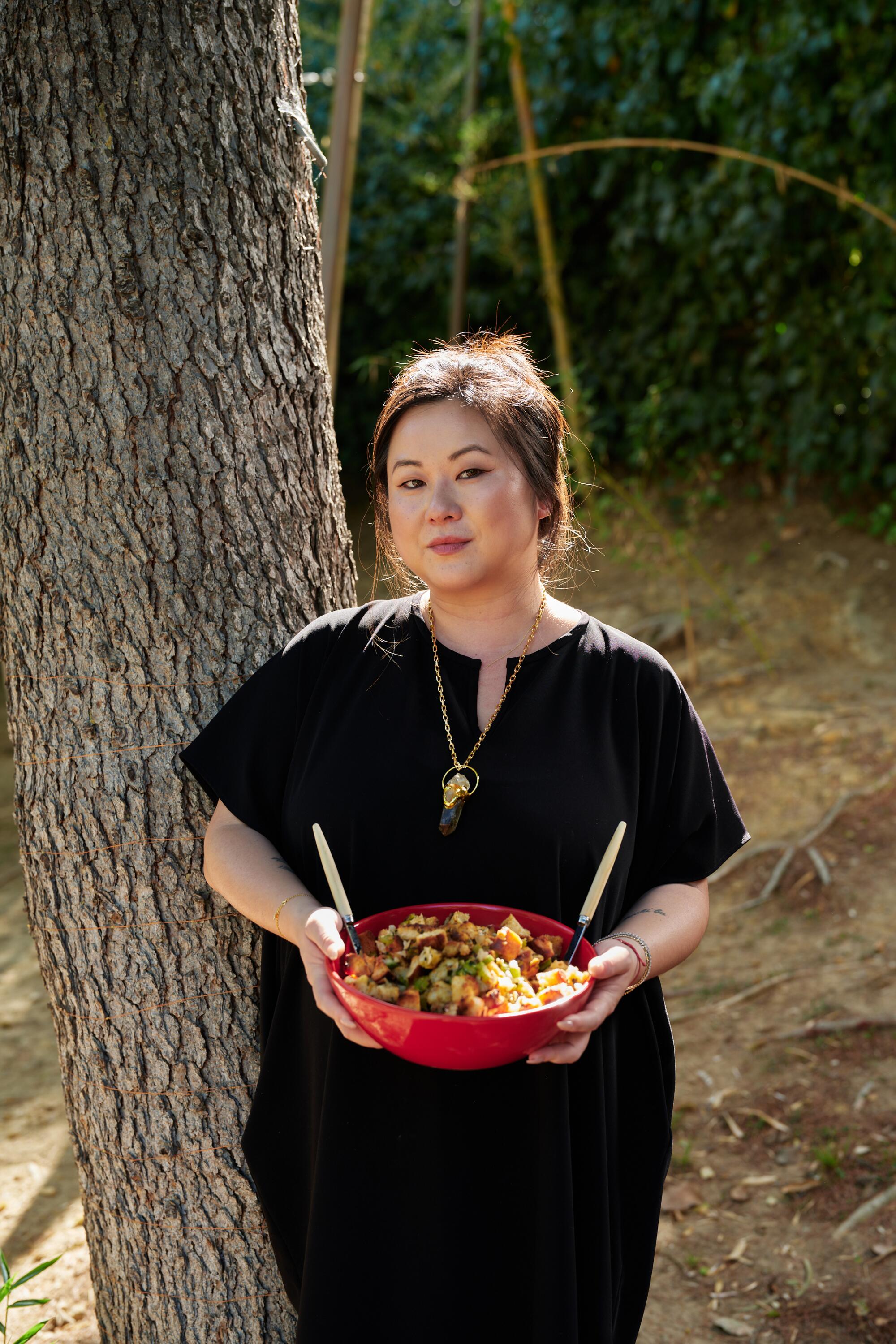
But no flavors are more important to her than those of China’s Sichuan province. She was born in its capital, Chengdu, and is a frank, ardent and entrepreneurial ambassador of its culinary heritage.
Long before she launched her food business — the foundation of which is her version of Sichuan chili crisp in all its spicy, funky, sludgy glory — her mission has been to “expand palates and minds,” challenging hierarchies of taste that have historically underestimated Chinese food.
By many measures, Gao, who is 36 years old, has succeeded already. She has sold more than 2 million jars of Fly by Jing Sichuan Chili Crisp, and it’s now available at thousands of stores across the country, including Costco, Target, Kroger and Ralphs. Her cookbook, “The Book of Sichuan Chili Crisp: Spicy Stories and Recipes From Fly by Jing’s Kitchen,” was published in October by Ten Speed Press. This month, along with fashion and beauty influencer Stephanie Liu Hjelmeseth, she is set to open Suá Superette, a grab-and-go market she describes as “Pret a Manger meets Sichuan flavors,” on Larchmont Boulevard.
You can find a jar of chili oil on the tables at countless restaurants and noodle shops in the San Gabriel Valley, but in the last two years, Los Angeles has experienced a chile sauce revolution.
Shake Shack and Panda Express plan to roll out Fly by Jing menu items in the coming months. A collaboration with Sun Noodle will bring a Fly by Jing ramen kit to Whole Foods. Another with Singapore-based Irvins, famous for its salted-egg potato chips, is in the works.
Chili crisp has arrived, and it’s everywhere, right?
No, it isn’t, says Gao, who has long dark hair and often wears a black or bold-colored dress and a chunk of citrine, “a very good business crystal,” around her neck. “A lot of people still don’t know what chili crisp is.
“It’s come a long way,” she says, “but whether it’s retailers or other brands bigger than us, they still say [chili crisp] is a trend or fad or not here to stay. I still have to go up against those assumptions.”
Sichuan x Thanksgiving
Into Gao’s blender goes cilantro, with Chinese black vinegar and soy sauce, then spiked with Sichuan pepper-infused oil. She’s testing her version of chimichurri to go with turkey, in between meetings and calls. Gao, on a brief break from her cookbook tour, is planning a dinner with Brandon Jiu at his Chinese American restaurant Mister Jiu’s in San Francisco. But first there is chimichurri to blitz.
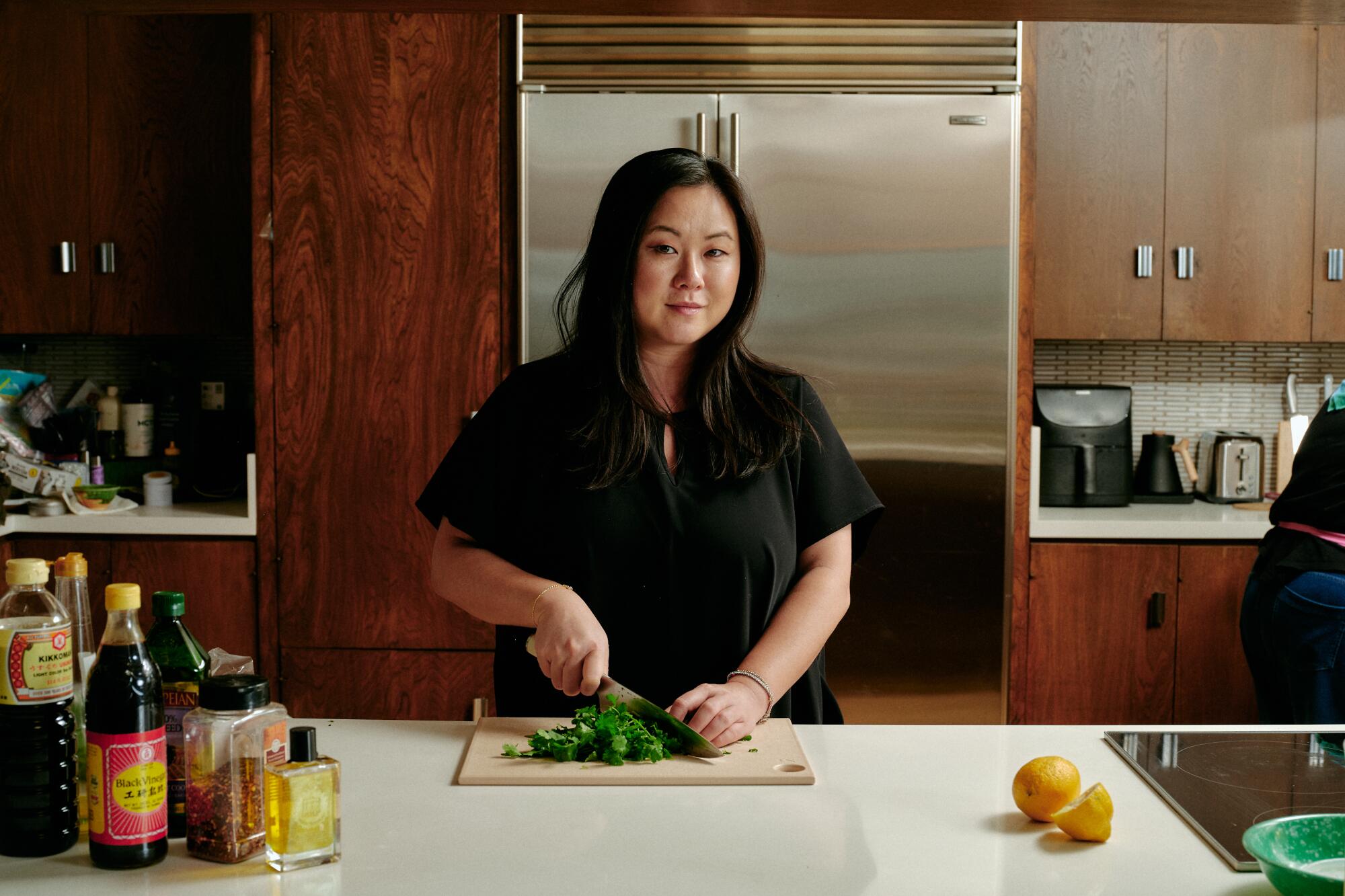
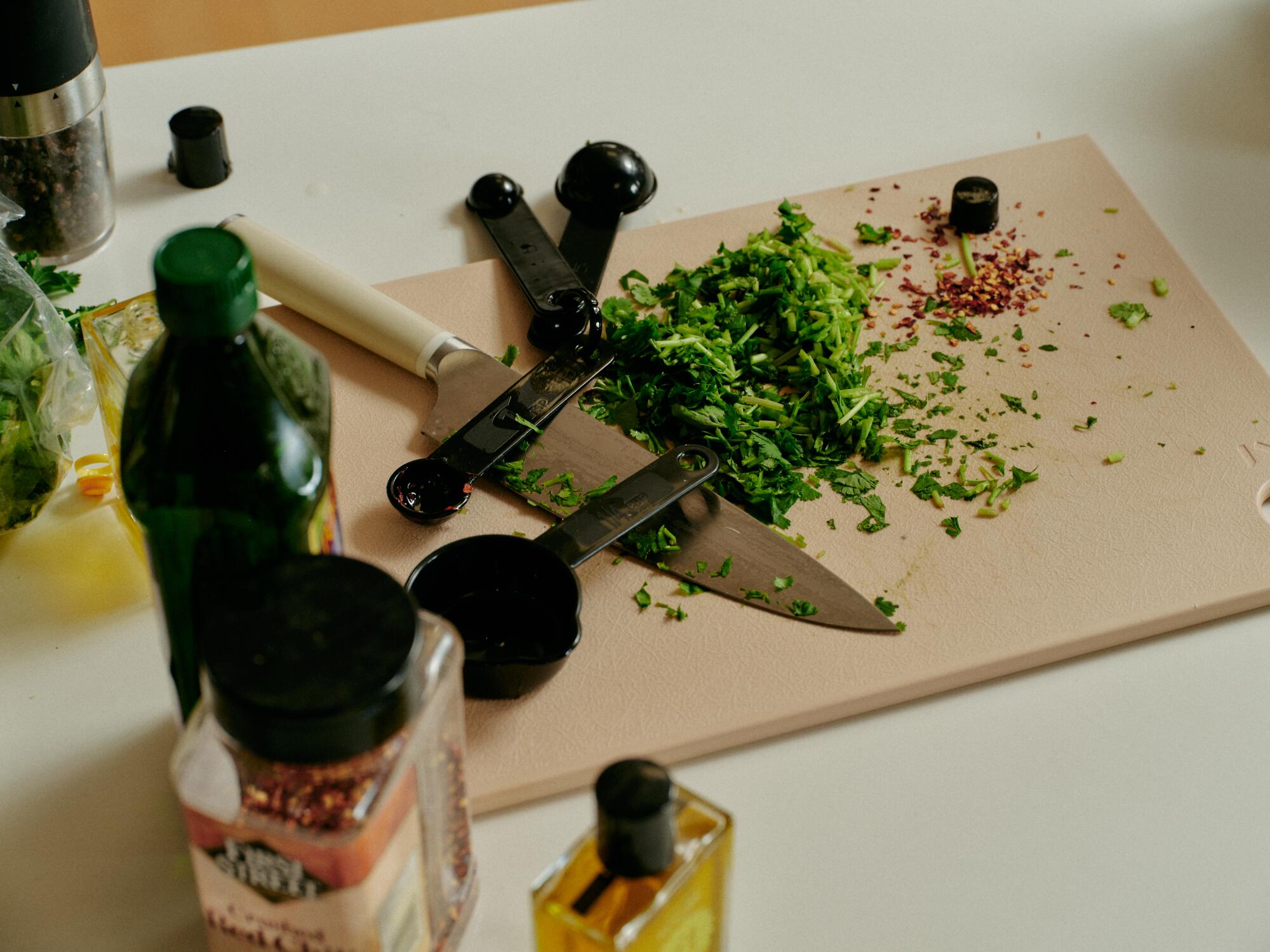
“Thanksgiving, to me, is the most personal meal,” she says as she scrapes the last of the sauce in the blender into a bowl. “Everybody makes it their own. In my time in the U.S. I’ve had many forms of Thanksgiving, and they’ve all been vastly different.
“Sichuan flavors are strong but are well balanced, savory with spicy and then the tingly, and the umami factor complements a lot of different canvases,” including roast turkey, sweet potatoes, green beans, even stuffing and pumpkin pie.
A former brand manager for Procter & Gamble and owner of a restaurant called Baoism in Shanghai, Gao started Fly by Jing first as an underground dinner series to connect to her roots. Fly is a reference to the hole-in-the-wall restaurants of Chengdu that are so delicious they attract people like flies. From city to city — Sydney, Hong Kong, New York — she carried meticulously sourced ingredients and homemade sauces with her in a suitcase.
Sichuan food is known for its seasoning and sauces, Gao says. A canon of compound flavors called fuhewei constitutes the heart of Sichuan cuisine. The most famous is mala, which electrifies with its combination of spicy chiles and numbing, tingly Sichuan pepper. But “there’s so much more,” Gao says. Mala is just one of dozens.

Each is a balance of flavors that culminate in xian, a complex umami quality — the high-wattage appeal of Sichuan cooking. Not all are spicy. Jiaoyan weixing — salt plus roasted ground Sichuan pepper — is more than the sum of its parts, used for savory and sweet alike, whether fried chicken or walnut cookies. Yu xiang, or “fish-fragrant” flavor mixes pickled chile, vinegar, sugar, ginger, garlic and scallions, evoking a sauce traditionally used for fish and other preparations. Those are just a couple of examples.
Chasing flavor is what led Gao to the mountains and countryside outside of Chengdu on trips to source ingredients. She was working with a chef in his Chengdu kitchen, asking questions: What’s this? Where is this from?
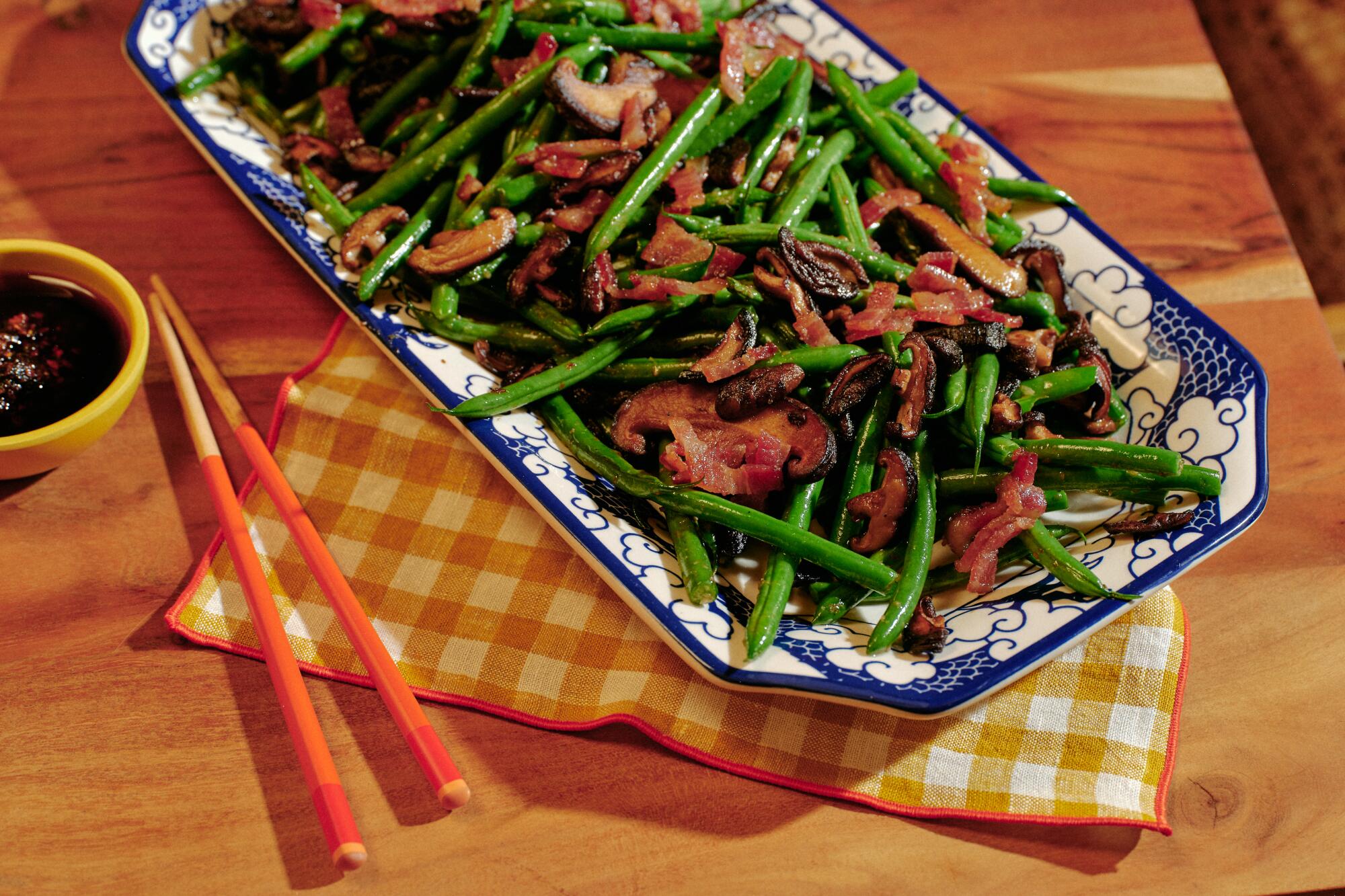
“The Sichuan pepper was so much better than any I had experienced, sourced every year at harvest time. The doubanjiang was this dark, brilliant red color, different from any I’d ever seen on store shelves.”
Doubanjiang is Chinese fermented bean paste, and Sichuan is distinctive for its use of fava instead of soy beans, and fragrant, fruity erjingtiao chiles.
Gao found purveyors and artisanal manufacturers, some who had been making their products for generations, even hundreds of years. “You can see the difference between their aged doubanjiang and mass-market versions.”
L.A. Times Food has partnered with Burlap & Barrel to make California Heat, our own custom spice blend inspired by chili crisp and the heat of Los Angeles.
She searched for ingredients that eventually would become Fly by Jing’s signature chili crisp — and more. The company she started by herself in 2019 (after a successful Kickstarter campaign) from an Airbnb in Silver Lake now also sells zhong sauce, mala spice mix, a hot pot starter kit, chili crisp vinaigrette and cold-pressed rapeseed oil infused with hand-harvested gong jiao, a variety of Sichuan pepper called Tribute because it’s said to be reserved as a tribute for emperors.
In April she visited Chengdu for the first time since the COVID-19 pandemic began in 2020 and created a new product, a Sichuan-style crispy-chile-beans-and-seeds condiment that she calls Chengdu Crunch.
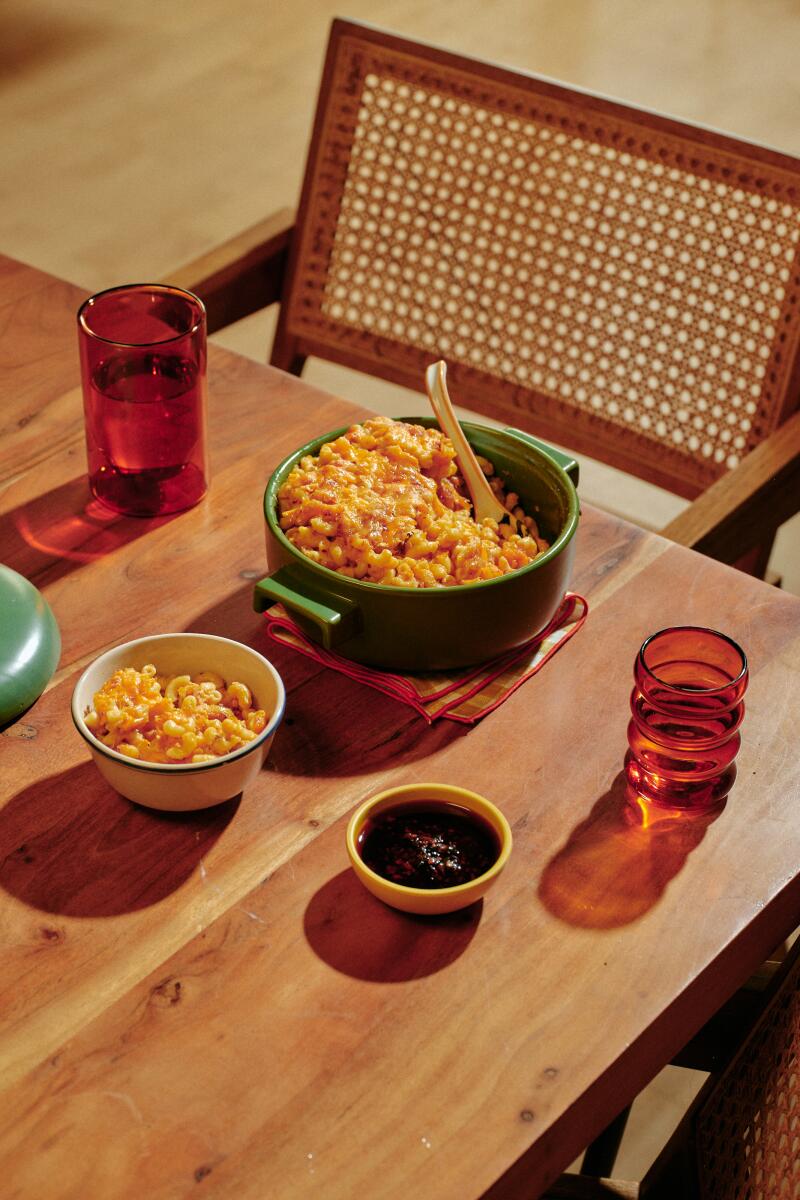

The cheese sauce for mac ‘n’ cheese is made with Sichuan chili crisp. (Shelby Moore / For The Times) Zhong sauce is the secret to these candied sweet potatoes. (Shelby Moore / For The Times)
“It really reconnected me to Chengdu, which is at its height right now, it’s the No. 1 city in China,” she says. “I lived in Beijing during the Olympics and Shanghai between 2012 and 2018, and now I think it’s Chengdu that has become this super-modern epicenter and still is in touch with its heritage. New restaurants and shops are so stylish and modern yet have maintained the spirit of the place.”
An original fusion cuisine
Part of its spirit is as a cultural crossroads. Chengdu sits in the center of Sichuan in a plain that’s known as both “the country of heaven” and “the land of abundance,” an area along the Silk Road that brought commercial and culinary trade, including spices. Chiles arrived from the Americas less than 300 years ago, which is considered recent in China.
“Sichuan cuisine isn’t ancient and is a product of constant evolution,” Gao says. The mixing of old and new ideas has made Sichuan cuisine one of the original fusion cuisines.
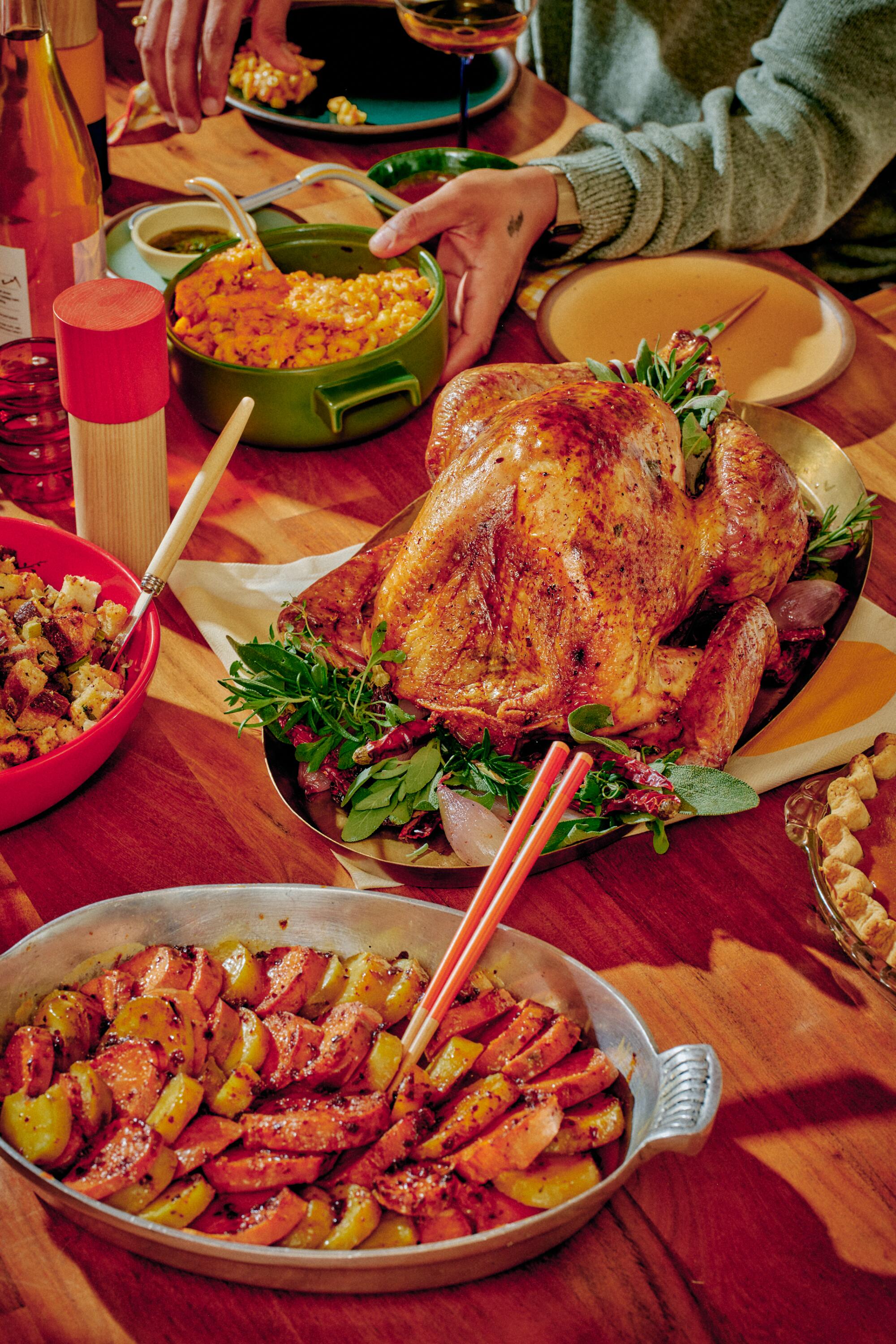
“When you have very rigid rules, you suppress the growth of something,” Gao says. “It prevents a cuisine from being pushed forward.”
So, at a recent collaboration dinner with chef Justin Pichetrungsi at Anajak Thai in Sherman Oaks to celebrate her cookbook, Gao served fish tacos with chili crisp and mapo tofu with lobster. Mapo tofu is an iconic Sichuan dish, but lobster is not a Sichuan thing; it’s landlocked. For another dinner, at Cantonese American restaurant Bonnie’s in New York, an Italian-Chinese cacio e pepe mein was prepared with doubanjiang, Pecorino cheese and Sichuan pepper. And a chow nai sundae of vanilla ice cream with malted fried milk starred chili crisp, mala malt powder, buttered peanuts and pork floss, the dried, shredded meat product that has the texture of cotton candy.
This version of mapo tofu from famed Chinese chef Yu Bo combines fiery, numbing spice with creamy avocado — yes, avocado.
Thanksgiving can evolve too.
For her roast turkey, Gao taps into the flavor profile of jiaoyan by creating a dry brine of salt and Sichuan pepper (which isn’t a peppercorn but the berry of a tree in the citrus family) along with erjingtiao chiles. The combination of salt and Sichuan pepper is often used as a condiment for roasted meats and here as part of a rub for the T-day bird, along with garlic and ginger. The result is an especially aromatic turkey with uniquely spiced flavors.
“I want to keep Thanksgiving relatable,” Gao says. “It has the visual identity of an American Thanksgiving dinner with Sichuan flavor.
“There’s a lot of prejudice and bias against othered cuisines and cultures. People have to make it their own, otherwise there’s no way to get started.”
Gao’s version of stuffing calls for a spice mix that includes chiles, fennel, cumin and star anise. They combine deliciously with the hardy herbs traditional to Thanksgiving. She brushes sweet potatoes — a combo of the Asian variety and yams — with her zhong sauce, inspired by the zhong dumplings Gao ate growing up. The glaze combines chiles, sesame oil, spiced soy sauce and a dose of brown sugar.
Chili crisp punches up mac ’n’ cheese, and more chiles season candied bacon for green beans. She laces pumpkin pie filling with Chinese five-spice powder and Sichuan pepper.
“To keep a cuisine alive, it needs to change, it needs to evolve,” Gao says as her spiced pumpkin pie goes into the oven. “Once your palate expands, there’s no going back.”
Get the Recipes
Salt and Sichuan Pepper Dry-Brined Turkey
Sichuan Chimichurri
Jing's Mala Stuffing
Zhong Candied Sweet Potatoes
Chili Crisp Mac ’n’ Cheese
Suá Green Beans with Shiitake 'Bacon'
Spiced Pumpkin Pie
More to Read
Eat your way across L.A.
Get our weekly Tasting Notes newsletter for reviews, news and more.
You may occasionally receive promotional content from the Los Angeles Times.
